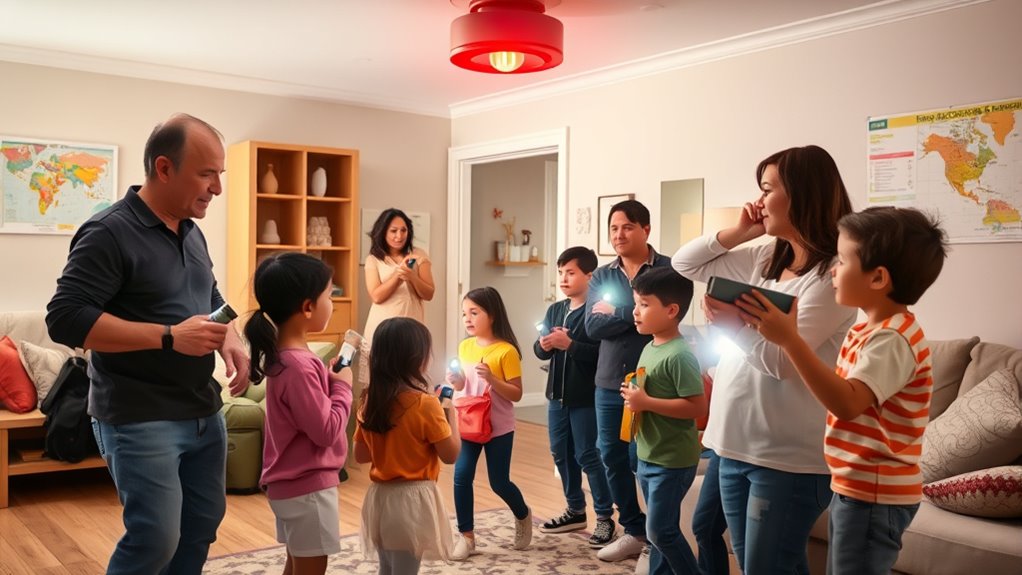Practicing family emergency drills and simulations helps you respond confidently during real crises. Make sure everyone understands escape routes, and regularly rehearse steps to escape fires or other hazards. Keep emergency kits accessible and practice grabbing them quickly. Use different scenarios to prepare for earthquakes, severe weather, or other emergencies. After each drill, review everyone’s performance and make improvements. Keep practicing often, and you’ll discover more tips to strengthen your family’s safety protocols.
Key Takeaways
- Regularly schedule family emergency drills to reinforce quick, confident responses in real situations.
- Incorporate scenario simulations using AI tools to prepare for diverse emergencies like fire or earthquakes.
- Practice escape routes and emergency kit retrieval during drills to ensure efficiency during actual incidents.
- Assign clear roles and maintain a calm tone to enhance active participation and effective responses.
- Conduct debriefs after each drill to identify improvements and update safety plans accordingly.

Have you ever thought about what you and your family would do in an emergency? It’s a question that might feel uncomfortable, but it’s essential to address. Practicing family emergency drills isn’t just about knowing what to do—it’s about building confidence and ensuring everyone’s safety when it counts most. One of the first steps is to establish clear fire escape plans. You need to identify multiple exits from each room, especially bedrooms and the kitchen, and make sure every family member understands how to use them quickly. Practicing these routes regularly helps turn a potentially chaotic situation into a swift, instinctive response. It’s also wise to designate a safe meeting spot outside your home, so you can quickly account for everyone once you’re out of danger.
Beyond fire escape plans, emergency kit preparedness plays an indispensable role in your preparedness strategy. Make sure your emergency kit is stocked with essentials like water, non-perishable food, first aid supplies, flashlights, batteries, and any necessary medications. During drills, incorporate the process of grabbing your emergency kit quickly and efficiently, so it becomes second nature. This way, in a real emergency, you won’t waste precious time searching for supplies or debating what to take. It’s equally important to periodically review and update your kit, replacing expired items and adjusting contents based on your family’s changing needs. Additionally, AI-driven insights from recent trends can help optimize your emergency plans by analyzing various scenarios and providing tailored recommendations for your family’s safety. Practicing family emergency drills should go beyond just talking about what to do; it’s about active participation. When you run through a drill, simulate different scenarios—whether it’s a fire, earthquake, or severe weather event—so your family learns to adapt. Use a calm but firm tone to guide everyone through their roles, emphasizing the importance of staying calm and following the plan. After each drill, hold a quick debrief to discuss what worked well and what could be improved. This feedback loop helps refine your approach, making future responses more effective.
Frequently Asked Questions
How Often Should Family Emergency Drills Be Conducted?
You should plan to conduct family emergency drills at least twice a year to make certain everyone stays prepared. Regular drill scheduling helps reinforce responses and identify areas needing improvement. By setting a consistent frequency planning, you make it easier to stay on top of preparedness efforts. Remember, practicing more often can boost confidence and quicken your family’s reaction time during actual emergencies. So, stick to a manageable schedule and review it regularly.
What Are Common Challenges Faced During Emergency Simulations?
It’s ironic how the biggest challenge during emergency simulations is often psychological preparedness—your own fear and doubts can hinder teamwork coordination. You might find it tough to stay calm or communicate clearly when panic sets in. These tests reveal how unprepared you feel emotionally, making it harder to work seamlessly with others. Overcoming these hurdles requires practice, trust, and mental resilience to make certain everyone remains coordinated when it truly counts.
How Can I Involve Young Children Effectively in Drills?
To involve young children effectively in drills, use engagement strategies that make activities fun and relatable. Incorporate age-appropriate activities like storytelling or simple role-playing to help them understand what to do. Keep instructions clear and short, and offer praise to boost confidence. By making the experience engaging and suited to their age, children will feel more comfortable and prepared during emergencies.
What Equipment Should Be Prepared for Family Emergency Kits?
Think of your emergency kit as a safety fortress. You’ll want emergency kit essentials like water, non-perishable food, a flashlight, batteries, a first aid kit, and hygiene supplies. Don’t forget family safety gear such as blankets, sturdy shoes, and copies of important documents. Keep everything organized in a waterproof container, ready to be activated at a moment’s notice. This preparedness transforms chaos into control, ensuring your family’s safety during a crisis.
How to Update and Improve Emergency Plans Over Time?
You should regularly review and update your emergency plan, focusing on strengthening family communication and ensuring plan flexibility. Sit down with your family to discuss recent changes in your lives or community hazards, and incorporate new information. Practice drills to identify gaps, then tweak your plan accordingly. Staying adaptable helps your family respond effectively, reducing confusion during actual emergencies and keeping everyone safe.
Conclusion
Practicing family emergency drills is like tuning a well-worn instrument—you may never need to play, but when the moment comes, you’ll be ready to perform in harmony. By regularly rehearsing, you build a safety net that catches your family in times of crisis. So, take the time now to prepare; it’s the glue that keeps your family’s safety and unity strong, ready to face any storm that comes your way.










